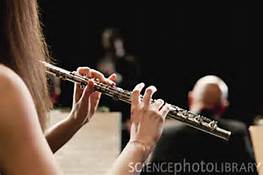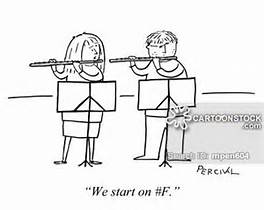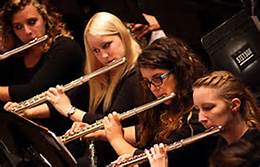Welcome to another edition of Flute Friday. I’m actually posting this on a Friday, for a change!

A few weeks ago I discussed auditioning tips for placement in school ensembles. By now most ensemble directors have assigned students to various parts for opening Fall semester concerts far and wide. What part did you land? Congratulations to those of you assigned to Principal and piccolo parts. Today’s blog is not for you. Playing 2nd Flute may initially feel like “always a bridesmaid, but never the bride,” (as the saying goes) but there is often more work required from the 2nd part than that of the Principal. You must be a chameleon but you must also be able to step up to the plate as a soloist when the music calls for it. Your part may be written to support the Principal flute but at other times you may also be required to lead the 2nd clarinet behind you, the 2nd oboe or bassoon to your far left, or in some circumstances, the 2nd and 4th horns two rows back. It’s a tough gig. Today’s blog is devoted to ways to approach the 2nd Flute part and the extremely valuable lessons that are gained by tackling this important musical role.

Get to know your Principal Both Personally and Musically. The relationship between Principal and 2nd Flute is at times tumultuous (for obvious reasons). Bruised or inflated egos and emotional reactions to competition often inhibit a very beneficial bond that could otherwise make both flutists perform better both individually and together, forming a stronger section within the orchestra. As a 2nd flutist, one of the most difficult things you may need to do to repair this bond, or start off on the right foot if you are new to the ensemble, is to leave your ego at the door. The audition is over. What’s done is done. It is time to learn how to be a team player and build your skills from a different perspective. You don’t have to be best friends with the Principal but you must have a strong enough relationship that he/she feels comfortable communicating musical decisions, fingerings, intonation, and dynamics with you without unnecessary interpersonal tensions. And vice versa! You must be able to ask questions and clarifications about the music whenever they arise. You are, after all, a team. Beyond being able to communicate verbally, you must also get to know how your Principal approaches their part. Listen closely and match pitch and vibrato speed whenever possible. Do they tend to play behind the beat? Are their B naturals a hair on the sharp side? Are their “pianos” a bit louder than marked? Do not judge. Match. This is probably the most difficult part about playing 2nd Flute. You must put aside your own opinions about how the music “should” be played and instead adhere to another player’s interpretation (which might not even be their own – it might be the conductor’s). Your time will come but until then playing 2nd helps you develop critical ensemble skills and strengthens your ability to listen, match, and play together as a team.

Listen, Listen, and Listen Some More. You will not always be playing the same notes or rhythms at the same time as the Principal. In fact, composers love to compose flute lines that dovetail moving figures between the two parts (think Smetana), therefore you will need to count, watch, and listen to make sure your part fits seamlessly with the Principal. There may also be times when you are not playing anything that fits in or around the Principal part at all and instead may be playing a duet with the clarinets or 2nd violins or a trio with the oboes and horns. Listen closely to your part both with a recording as well as in rehearsal and write reminders in the score to draw your attention to your role and other instruments that may be playing the same line at the same time. Match styling, pitch, and tempo whenever possible. You are indeed the chameleon. Flexibility is therefore of the utmost importance for the successful performance of a 2nd Flute part.
Get Ready to Take the Reins. Despite what you may think, playing 2nd part does not mean you get to sit back with your feet up, sipping Starbucks, occasionally playing a few unimportant notes, and watching innocently as the players around you sweat out the score. You will occasionally be the soloist. That low G natural at the end of the movement may just be you and a few lower strings. Be ready! Smetana, Dvorak, and Ravel are notorious for including soloistic writing for the 2nd flute part and they are not alone. Be prepared to transform momentarily into a soloist without much warning. Play out! Enjoy your rock star moments. Shine.

You still need to watch the conductor. Do not simply let the Principal take the fall for whole section. You will still need to follow the conductor’s beat and cues. A very common criticism from conductors is that the 2nd flute part does not play loudly enough. Be on the lookout for the universal signs from the conductor indicating “more sound.” 2nd flutes are often written in the middle and lower registers which are significantly more difficult to project than notes in the high register. Keep this in mind for anything written in dynamics louder than mezzo forte. Project these parts slightly more than you would in a solo scenario to properly support the voices that may be sounding above your part for proper balance.
And finally,
Be a Reliable Member of your Section. If you are going to be absent from rehearsal or are running late, make sure to inform your section leader, personnel manager, or director ASAP and arrange for a sub. This, again, assumes that you are in good communication with the other members of your ensemble. An orchestra often has a substitute list of other flute players in the community that they may call upon in your absence, but you may also want to have a back-up list of your own to share with your section leader. If you unexpectedly find yourself in a situation that prevents you from attending a rehearsal or performance, you or your section leader will be able to quickly find a good, last minute solution.

Do you play 2nd Flute in a school or professional ensemble? What do you think is this most important aspect about playing 2nd Flute? Do you have any stories about playing 2nd Flute that have changed your approach to the part? Please comment below!
Happy Fluting!



Leave a comment